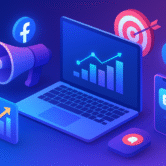- Your cart is empty Browse Shop
Introduction
In today’s digital age, marketing has moved online. With 5.56 billion people using the internet globally as of 2025wix.com, the web is the largest marketplace on earth. Digital marketing – the practice of promoting products and services via online channels – is now crucial. By definition, “digital marketing is the use of digital channels to promote a product or service. It’s the opposite of offline marketing…”wix.com. In fact, global digital ad spend is projected to top $700 billion by 2025wix.com, underscoring how indispensable it has become.
The result: businesses must meet customers where they spend time – online. Social media, search engines, email, video and more now replace billboards and cold calls. For example, at Cyber Tech Creations we’ve seen small brands explode online by shifting ad spend to Facebook and Google rather than flyers or print ads. Studies back this up: digital ads can boost brand awareness by up to 80%wix.com, and 66% of marketers report increased credibility and trust from digital strategieswix.com. In short, digital marketing reaches farther, targets smarter, and is far more measurable than traditional methods.
Image: A smartphone screen shows popular social media apps (Facebook, Twitter, etc.). Social platforms connect billions, making them prime channels for marketersdatareportal.com. Social networks alone boast 5.04 billion users worldwide (62.3% of the global population) in 2024datareportal.com. Platforms like Facebook, Instagram, LinkedIn and TikTok aren’t just for socializing – they’re key marketing battlegrounds. Meanwhile, roughly 33% of consumers find new brands via search engineshubspot.com, highlighting why search and content are also critical. In other words, digital marketing lets you reach people on the devices they use constantly, any time of day.
Digital vs. Traditional Marketing: A Comparison
How does online marketing compare to older methods? The differences are striking:
| Aspect | Digital Marketing | Traditional Marketing |
|---|---|---|
| Cost | Generally low and flexible (e.g. pay-per-click, often near $0 CPMlyfemarketing.com) | High fixed costs (e.g. a full-page magazine ad ~$120Klyfemarketing.com) |
| Targeting | Highly specific (demographics, interests, behaviorswix.com) | Broad (mass audience via TV/radio/print) |
| Engagement | Interactive (social comments, emails, videos)lyfemarketing.com | One-way (audiences see ads passively) |
| Analytics & ROI | Real-time metrics, precise ROI trackinglyfemarketing.com | Hard to measure (rely on estimates, recall) |
| Reach & Scale | Global, 24/7 online access (billions of internet userswix.comdatareportal.com) | Local/regional; limited by distribution |
| Flexibility | Quick updates/optimization in real timelyfemarketing.com | Slow changes (long lead times and production) |
These contrasts mean digital marketing often delivers higher ROI. For example, Lyfe Marketing notes that a print magazine’s CPM can exceed $50lyfemarketing.com, whereas online ads charge per click (often effectively lowering CPM to zero)lyfemarketing.com. Plus, over 80% of shoppers research online before buyinglyfemarketing.com, so neglecting digital channels risks missing most customers. In essence, digital strategies cost less, reach farther, and allow continuous optimization – whereas traditional channels demand big budgets and yield murky results.
Key Digital Marketing Channels & Insights
Search Engine Optimization (SEO)
A cornerstone of online marketing, SEO is the practice of optimizing your website to rank higher in search results. When your site appears on page one of Google or other engines, your traffic and leads can soar. According to industry data, about 32.9% of internet users discover new brands via searchhubspot.com – nearly one in three people! So focusing on SEO (good content, keywords, technical speed) pays off. For instance, we’ve helped clients fine-tune blog content with targeted keywords and seen organic traffic jump by 30% in months.
Image: Scrabble tiles spelling “SEO” – illustrating how search optimization underpins digital marketing success. To illustrate, even simple SEO steps (like better page titles and mobile-friendly design) can dramatically boost visibility. Because search holds roughly 41% of the digital ad marketwordstream.com, it remains a workhorse channel. The goal is to get your website to the top of search results so customers “find” you instead of the other way around.
Content Marketing
Content marketing – creating valuable blog posts, videos, infographics, etc. – goes hand-in-hand with SEO. Good content builds trust, answers customer questions, and fuels many channels. In fact, content is so powerful that in 2024, blog posts were the fourth most-used content format (19.5%) among marketers, behind short videos and imageshubspot.com. At Cyber Tech Creations, we often advise new businesses to start a blog: targeted, helpful posts bring readers in and establish expertise.
Notably, marketers are harnessing AI in content. Over half (54%) of content teams now use AI tools to brainstorm ideashubspot.com, though few (about 6%) fully automate writing. The result? Faster ideation and tighter strategies. But quality still matters – long-form, well-researched content (the average blog is now ~1,400 wordshubspot.com) usually beats shallow pieces in SEO and engagement. Whether it’s how-to guides, case studies, or entertaining videos, content marketing remains a top way to engage audiences and funnel them toward conversion.
Social Media Marketing
Social media platforms offer unmatched reach and engagement. With 5.04 billion people on social networksdatareportal.com, posting on Facebook, Instagram, TikTok, LinkedIn, and the like lets brands target specific demographics with ads or viral content. Social also enables two-way engagement: responding to comments, running live Q&As, or building community around a brand. A Lyfe Marketing survey found 90% of B2C companies see social media as their most effective content tacticlyfemarketing.com.
In practice, social ads are highly targeted. You can specify age, location, interests – ensuring your message hits the right people. For example, we ran a campaign targeting pet owners within 20 miles of a client’s store and saw a 25% higher click-through than a general campaign. Plus, trends like short-form video (Reels, TikTok) boost reach: 86% of consumers want to see more video content from brandswordstream.com. Overall, social media marketing builds brand awareness and helps form lasting customer relationships via interactive channels (comments, shares and instant messaging are far more engaging than a static print ad).
Pay-Per-Click (PPC) Advertising
PPC (search and social ads) offers instant visibility and lead generation. Instead of waiting for organic traffic to build, businesses pay to place ads. This method can deliver very strong ROI. For example, Google reports that companies typically earn about $2 for every $1 spent on Google Ads (a 200% return)wordstream.com. Similarly, Facebook Ads frequently top ROI charts in industry surveyswordstream.com. In practical terms, we often see clients using a modest budget on Google/PPC yield twice the conversions of a broader ad. The key is ongoing optimization: since digital ads are measurable in real time, you can pause poor performers or boost winners, squeezing out maximum value. If print ad CPM can be $50lyfemarketing.com, a well-optimized PPC campaign can cost nearly $0 CPM (you only pay when people click)lyfemarketing.com.
Email Marketing
Email marketing remains a powerhouse for ROI, especially in B2C. One study found email marketing returns $36 to $40 for every $1 spentwordstream.com. Nearly half of small businesses even say email provides their highest ROI of all channelswordstream.com. The secret is that it nurtures customers directly in their inbox, and campaigns can be highly personalized. For example, sending a series of welcome emails or abandoned-cart reminders can significantly boost sales without high media spend. We’ve used email funnels for clients that tripled their e-commerce conversion rate within weeks. Email performance is easy to track (open rates, clicks, conversions) and almost everyone checks their email daily, making it an evergreen digital marketing staple.
Video Marketing and Emerging Trends
Video content is booming. In fact, video is the most popular media tactic for content marketerswordstream.com, and over 90% of companies now consider it a key part of their strategywordstream.com. Platforms like YouTube, Instagram Reels, and TikTok have transformed engagement: short, entertaining clips capture attention in ways that static posts can’t. Consumers love video – 86% say they want more video from their favorite brandswordstream.com. We advise brands to leverage behind-the-scenes clips, product demos or customer testimonials; we’ve seen a tech client’s website traffic spike 40% after launching a YouTube tutorial series.
Other trends: marketing automation and AI are reshaping the field. About 76% of brands used automation tools last yearwordstream.com to schedule posts, segment audiences, and run email campaigns with less manual work. AI-powered chatbots and ad optimization tools also allow marketers to work smarter. For example, thanks to cloud platforms, a marketer can tweak ad campaigns from anywhere (even on a laptop in the park)lyfemarketing.com. We’ve also seen interest in AR/VR (42% of firms planning to invest in the next yearwordstream.com) and voice search optimization, reflecting how consumers adopt new tech. Staying ahead means testing these trends: early adopters often gain a competitive edge online.
Image: A marketer working remotely on a laptop in a relaxed setting – illustrating how digital tools let teams work from anywhere and adjust campaigns in real time. Modern digital marketing is also about flexibility. Ads and content can be created and modified on the fly – from a home office or hotel room. For instance, if an ad isn’t performing, we can pause it and A/B-test a new version in minutes, something unthinkable with print or TV buys. This agility is a huge advantage in fast-moving markets.
Conclusion & Call to Action
Digital marketing is not a fad – it’s the new standard. By blending the channels above (SEO, content, social, email, video, etc.) and rigorously measuring results, businesses can connect with customers in precise, cost-effective ways. The data is clear: around 72% of marketing budgets now go to digital channelswordstream.com, and digital marketing spend is growing rapidly worldwidewordstream.com.
What’s your take on digital marketing? We encourage you to share experiences or questions in the comments. If you’re running a small business, consider how a stronger online strategy could amplify your reach – even with a modest budget. Subscribe to our newsletter or reach out to Cyber Tech Creations for more insights and tips. Let’s keep this conversation going and help each other navigate the evolving world of digital marketing!






